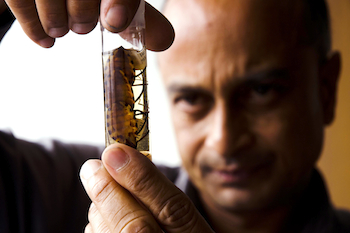 Sahotra Sarkar inspects one of the triatomine species that may be a carrier of the parasite that causes Chagas disease. Photo by Marsha Miller.AUSTIN, Texas—Chagas disease, a tropical parasitic disease that can lead to life-threatening heart and digestive disorders, may be more widespread in Texas than previously thought, according to research from The University of Texas at Austin.
Sahotra Sarkar inspects one of the triatomine species that may be a carrier of the parasite that causes Chagas disease. Photo by Marsha Miller.AUSTIN, Texas—Chagas disease, a tropical parasitic disease that can lead to life-threatening heart and digestive disorders, may be more widespread in Texas than previously thought, according to research from The University of Texas at Austin.
“We’ve been studying this for four years now, and this year the number of disease-causing insects is quite amazing,” says Sahotra Sarkar, professor of integrative biology and philosophy at The University of Texas at Austin and lead author of a paper on the disease published in PLoS Neglected Tropical Diseases.
Endemic to rural areas of Latin America, Chagas disease is often transmitted by triatomine bugs, also known as “kissing bugs.”
In order to assess the prevalence of Chagas disease in Texas, Sarkar is working with a network of health professionals and researchers around the state. After collecting and classifying insects from the field, Sarkar sends them to Philip Williamson, an assistant professor at The University of North Texas Health Science Center. Williamson determines how many of the bugs carry Trypanosoma cruzi, the protozoa which causes the disease.
From the data Sarkar creates epidemiological maps showing the number and location of carrier insects, recorded human Chagas infections and hospitable habitats for the insects.
 A composite risk map for Chagas disease in Texas. According to Sarkar's analysis eleven counties are at particular risk: Bee, Bexar, Brooks, Cameron, DeWitt, Goliad, Hidalgo, Jim Wells, Kenedy, Kleberg, and Nueces.The maps suggest South Texas is an area of high risk for Chagas infection. Sarkar says there may already be hundreds of undiagnosed cases of the disease.
A composite risk map for Chagas disease in Texas. According to Sarkar's analysis eleven counties are at particular risk: Bee, Bexar, Brooks, Cameron, DeWitt, Goliad, Hidalgo, Jim Wells, Kenedy, Kleberg, and Nueces.The maps suggest South Texas is an area of high risk for Chagas infection. Sarkar says there may already be hundreds of undiagnosed cases of the disease.
Chagas can be hard to detect because it can look like the flu at first, with symptoms similar to pains and fever. The symptoms appear to go away but the disease can live in a person for decades, sometimes reappearing in the form of digestive or heart failure.
In Texas, where most doctors are not familiar with the disease and are not required to report it to public health officials, they may misinterpret its late-onset symptoms as an old age problem, says Sarkar.
“So it doesn’t get diagnosed at the beginning, and it doesn’t get diagnosed at the end,” he says.
Until further research is done, Sarkar and his colleagues won’t be able to say for sure how widespread the disease is. They believe the risks are high enough, however, to recommend a few low-cost, low-impact changes to the way the Texas public health system deals with Chagas.
They say Chagas should be designated as a reportable disease, which would require health professionals to report incidences of it to the Texas Department of State Health Services. Efforts should be launched in South Texas to more thoroughly determine the prevalence of Chagas in humans, dogs and wild species (particularly rats) that often act as reservoirs of the disease. And there should be mandatory screening of blood donations for the presence of Chagas. Currently, screening is voluntary and only done with about 65 percent of samples.
In the future, Sarkar would like to see Mexico and the U.S. collaborate on a multi-layered attack on the disease. He points to the success of the Southern Cone Initiative in South America as a model. Simple changes in lifestyle, such as keeping piles of wood away from the home and encouraging people to switch from adobe or wooden houses to concrete, have been effective. Selective spraying for the insects has also been key to decreasing the burden of the disease in South America.
For more information contact: Daniel Oppenheimer, oppenheimer@mail.utexas.edu, (512) 232-0682.

















Comments 3
I would like to know what is meant by "south Texas." Which counties is the data actually describing? I ask because I am from "South Texas".
-shelby
I just added one of the maps from the paper. The caption indicates which counties are considered high risk. There are more maps in the paper, which is linked to in the second paragraph above. -Dan
I'm relieve learning from you, but I'm disagreeable to achieve my goals. I dead screw measurement all that is posted on your parcel.Livelihood the tips upcoming. I enjoyed it!